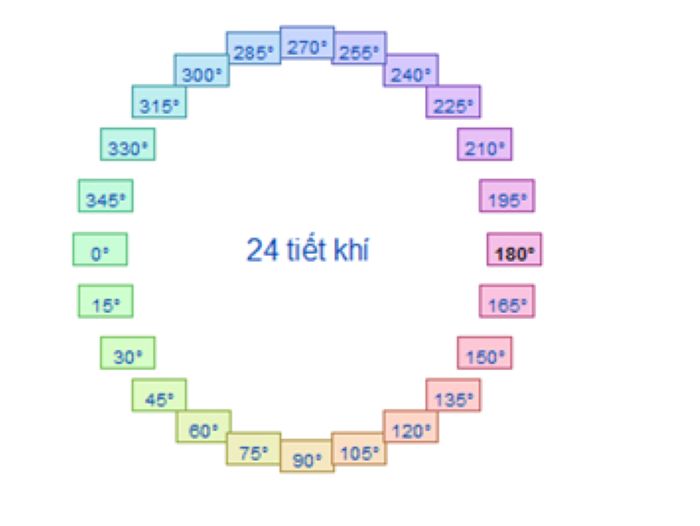What is solar term?
Solar term refers to 24 special points on the Earth’s orbit around the Sun, with each point 15° apart.
Solar term is used in the calendar system of ancient Eastern civilizations such as China, Japan, Korea, and Vietnam to synchronize the seasons within a year. Solar term is also referred to simply as “term”.
When looking at the solar term calendar, we divide the plane of space into 360°, and the days when the Sun is at specific coordinate positions are called solar terms.
According to the perpetual calendar, there are 24 solar terms in a year. These are also the positions of the Sun at longitudes: 0°, 15°, 30°, 45°, 60°, 75°, 90°, 105°, 120°, 135°, 150°, 165°, 180°, 195°, 210°, 225°, 240°, 255°, 270°, 285°, 300°, 315°, 330°, 345° relative to the Earth. The diagram below illustrates this.

Classification of the 24 solar terms in a year: They are divided into 4 categories as follows:
- Representing temperature changes: there are 8 solar terms: Beginning of Spring, Spring Equinox; Beginning of Summer, Summer Solstice; Beginning of Autumn, Autumn Equinox; Beginning of Winter, Winter Solstice.
- Representing temperature changes: there are 5 solar terms: Minor Heat, Major Heat, Grain in Beard, Minor Cold, Major Cold.
- Representing rain and water: there are 7 solar terms: Rain Water, Awakening of Insects, Clear and Bright, Grain Rain, Start of Heat, Minor Snow, Major Snow.
- Representing natural phenomena: there are 4 solar terms: Insects Waking Up, Clear and Bright, Grain Full, Grain in Ear.
Meaning of the 24 solar terms in a year, their names, and corresponding times
Spring Solar Terms
Spring solar terms include: Beginning of Spring, Rain Water, Waking of Insects, Spring Equinox, Clear and Bright, and Grain Rain.

The 1st solar term – Beginning of Spring: Beginning of Spring falls on either February 4th or 5th in the Gregorian calendar each year. “Beginning” means the start or mark. “Spring” means the spring season. Therefore, the Beginning of Spring marks the beginning of spring and the start of a new year. According to folklore, this is a time of new beginnings and good luck. From an astronomical point of view, the Beginning of Spring marks a new orbit of the Earth around the Sun.
The 2nd solar term – Rain Water: Rain Water falls on either February 19th or 20th in the Gregorian calendar each year. Rain Water refers to the beginning of spring rains, with small drizzles. At this time, the Spring wind blows everywhere, the air is humid, and there is a lot of rain, so it is called Rain Water.
The 3rd solar term – Waking of Insects: Waking of Insects falls on either March 6th or 7th in the Gregorian calendar each year. Waking of Insects signifies that some insects and pests begin to breed and hatch. When spring comes, trees sprout and insects and pests begin to emerge.
The 4th solar term – Spring Equinox: Spring Equinox falls on either March 21st or 22nd in the Gregorian calendar each year. This is the midpoint of the spring season. On this day, the Sun is directly over the Equator. This is the middle point of the 90-day Spring season, and on this day, the day and night are equal in both the Southern Hemisphere and the Northern Hemisphere, so it is called Spring Equinox. After this day, the direct position of the Sun begins to shift towards the North Hemisphere, so the days become longer and the nights become shorter. Therefore, Spring Equinox can be considered as the start of spring in the Northern Hemisphere, where plants have survived the cold of winter and are entering a period of growth under the warm sun.
The 5th solar term – Clear and Bright: Clear and Bright falls on either April 5th or 6th in the Gregorian calendar each year. At this time, the climate is warm and cool, and plants begin to sprout and grow.
The 6th solar term – Grain Rain: Grain Rain falls on either April 20th or 21st in the Gregorian calendar each year. Grain Rain means rain showers.
Summer Solar Terms
Summer solar terms include: Beginning of Summer, Grain Full, Grain in Beard, Summer Solstice, Minor Heat, and Major Heat.

The 7th solar term – Beginning of Summer: Beginning of Summer falls on either May 6th or 7th in the Gregorian calendar each year. This is the beginning of the summer season, and everything starts to grow vigorously. Beginning of Summer is an important solar term with a noticeable increase in temperature, approaching hot weather, heavy rain, and rapid growth of plants.
The 8th solar term – Grain Full: Grain Full falls on either May 21st or 22nd in the Gregorian calendar each year. During this time, summer showers and small flooding can occur, so it is called Grain Full.
The 9th solar term – Grain in Beard: Grain in Beard falls on either June 6th or 7th in the Gregorian calendar each year. Grain in Beard signifies that some insects and pests have begun to hatch. When spring comes, trees sprout, and insects and pests begin to emerge.
The 10th solar term – Summer Solstice: Summer Solstice falls on either June 21st or 22nd in the Gregorian calendar each year. This is the middle of the summer season. The sunlight is almost directly overhead at the Tropic of Cancer, and on this day, the Northern Hemisphere has the longest daylight hours and the shortest nights.
The 11th solar term – Minor Heat: Minor Heat falls on either July 7th or 8th in the Gregorian calendar each year. This is the time when the weather is already hot, but not the hottest, so it is called Minor Heat.
The 12th solar term – Major Heat: Major Heat falls on either July 22nd or 23rd in the Gregorian calendar each year. Major Heat is the hottest solar term of the year.
Autumn Solar Terms
Autumn solar terms include: Beginning of Autumn, Limit of Heat, White Dew, Autumn Equinox, Cold Dew, and Frost’s Descent.

The 13th solar term – Beginning of Autumn: Beginning of Autumn falls on either August 8th or 9th in the Gregorian calendar each year. Beginning of Autumn marks the beginning of autumn, with temperatures and sunlight decreasing, and chrysanthemums starting to bloom.
The 14th solar term – Limit of Heat: Limit of Heat falls on either August 23rd or 24th in the Gregorian calendar each year. At this time, the temperature of the hot summer begins to drop, making the climate pleasant and cool.
The 15th solar term – White Dew: White Dew falls on either September 8th or 9th in the Gregorian calendar each year. White Dew means faint sunshine. At this time, the weather becomes much cooler.
The 16th solar term – Autumn Equinox: Autumn Equinox falls on either September 23rd or 24th in the Gregorian calendar each year. This is the middle of the autumn season. The amount of sunlight and temperature continue to decrease.
The 17th solar term – Cold Dew: Cold Dew falls on either October 8th or 9th in the Gregorian calendar each year. Cold Dew means cold weather. At this time, the weather turns much colder, and there is a lot of dew at night.
The 18th solar term – Frost’s Descent: Frost’s Descent falls on either October 23rd or 24th in the Gregorian calendar each year. The weather becomes very cold, and frost begins to form.
Winter Solar Terms
Winter solar terms include: Beginning of Winter, Minor Snow, Major Snow, Winter Solstice, Minor Cold, and Major Cold.

The 19th solar term – Beginning of Winter: Beginning of Winter falls on either November 7th or 8th in the Gregorian calendar each year. Beginning of Winter is the first solar term of the winter season.
The 20th solar term – Minor Snow: Minor Snow falls on either November 22nd or 23rd in the Gregorian calendar each year. This is the time when there is some snow in northern areas such as China, Korea, and Japan, but it is still minimal, hence the name Minor Snow.
The 21st solar term – Major Snow: Major Snow falls on either December 7th or 8th in the Gregorian calendar each year. During this time, the northern regions (China, Korea, Japan) receive more snow and the rivers begin to freeze, marking the onset of very cold weather in the northern regions.
The 22nd solar term – Winter Solstice: Winter Solstice falls on either December 21st or 22nd in the Gregorian calendar each year. This is the midpoint of the winter season. On this day, the Sun is closest to the Tropic of Capricorn, and at this time, the Northern Hemisphere has the shortest daylight hours and the longest nights.
The 23rd solar term – Minor Cold: Minor Cold falls on either January 5th or 6th in the Gregorian calendar each year. Minor Cold means slight coldness. After this day, the weather enters the coldest part of winter, but it is still not at its extreme, so it is called Minor Cold.
The 24th solar term – Major Cold: Major Cold falls on either January 20th or 21st in the Gregorian calendar each year. Major Cold means extremely cold weather, bone-chilling coldness. After Major Cold, the weather gradually becomes warmer until the Beginning of Spring, when the temperature starts to rise again. By this time, the Earth has completed one orbit around the Sun, completing a cycle known as a year, with 24 solar terms in total.



































